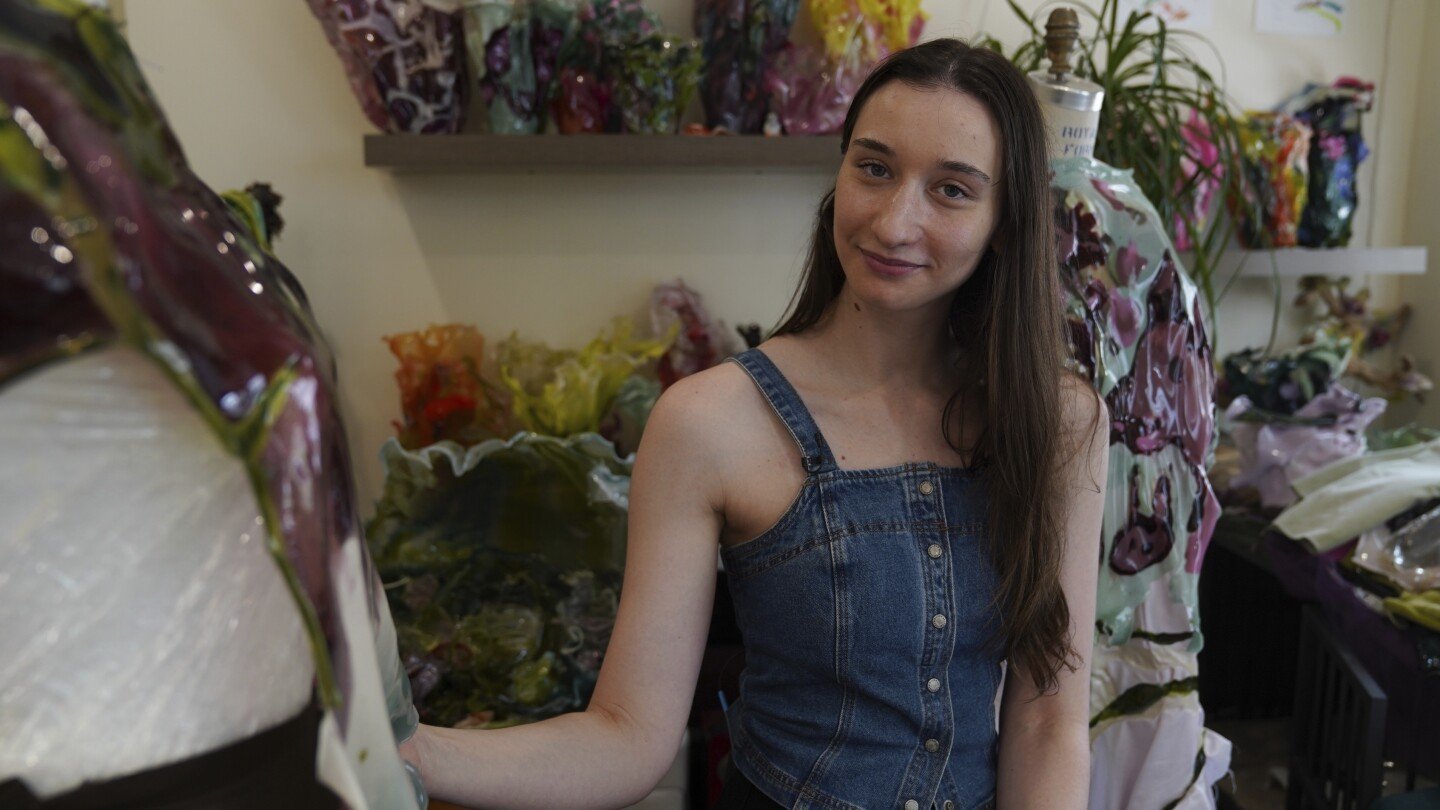Lifestyle
Japan’s emperor prays for the Okinawa war dead 80 years since the battle

TOKYO (AP) — Japan’s Emperor Naruhito and his family prayed on Wednesday in Okinawa for all the war dead in one of the bloodiest battles of World War II that was fought on the southern Japanese island 80 years ago.
The commemoration comes as many residents of Okinawa and the nearby islands are increasingly concerned about the possibility of another war as regional tensions with China escalate.
Naruhito’s father, the 91-year-old former Emperor Akihito, cared especially about Okinawa because of its difficult history, setting an example for his son.
The emperor and his wife, Empress Masako, asked their 23-year-old daughter, Princess Aiko, to accompany them on Wednesday’s trip in an apparent effort to convey their attention for history on the next generation. It is Aiko’s first visit to Okinawa.
The three first headed to the island’s last battlefield of Itoman and laid white flowers before an ossuary at the National War Dead Peace Mausoleum, where the remains of most of the victims are placed.
The Battle of Okinawa began on April 1, 1945 when the U.S. troops, in their push for mainland Japan, landed on the island. It lasted until late June, killing more than 200,000 people. Nearly half of them were civilian residents of Okinawa, including students and victims of mass suicides ordered by the Japanese military, which waged the war in the name of Naruhito’s grandfather, late Emperor Hirohito.
On June 23, the island will mark the 80th anniversary of the end of the Battle of Okinawa, which led to heavy American troop presence on the island, even after the nearly 30 years of U.S. occupation ended in 1972.
Naruhito, in his birthday remarks in February, stressed the importance of telling the tragedy of World War II to younger generations, pledging to contribute to efforts to promote the understanding of history and the determination for peace.
The imperial family later on Wednesday visited the Cornerstone of Peace memorial, which has the engraved names of about a quarter million war dead on the Mabuni Hill where the battle ended. They also visited a permanent war exhibit at the Okinawa Prefectural Peace Memorial Museum and met with the survivors and families of those bereaved in the battle.
Wednesday’s visit was Naruhito’s seventh visit to Okinawa. He last visited in 2022 to mark the 50th anniversary of Okinawa’s reversion to Japan.
Lifestyle
Man charged after kilt-wearing attacker smashes case holding Scotland’s Stone of Destiny

LONDON (AP) — A man from Australia has been charged with “malicious mischief” for allegedly smashing a glass case holding the Stone of Destiny, an ancient symbol of Scottish nationhood.
Arnaud Harixcalde Logan, 35, appeared at Perth Sheriff Court on Monday to face the charge, which is similar to vandalism.
Logan, whose address was given as Sydney, wasn’t asked to enter a plea and was ordered detained until a hearing next week.
Police said that they were called to a “disturbance” at Perth Museum in central Scotland on Saturday, after reports of a kilt-wearing man attempting to smash the case containing the royal rock.
The 335-pound (150-kilogram) sandstone block is also known as the Stone of Scone (Skoon) — and was used in the crowning ceremonies of medieval Scottish monarchs at Scone Abbey, near Perth. It was stolen by England’s King Edward I in the 13th century and taken to Westminster Abbey in London, where it was installed under the seat of the coronation chair.
It has been used in coronations at the abbey ever since — first of English and then of British monarchs The English and Scottish crowns were united under one monarch in the 17th century.
The stone’s presence in London long irked Scottish nationalists. In 1950, it was stolen from Westminster Abbey by four Glasgow university students, but was returned in time for the coronation of Queen Elizabeth II in 1953.
It was given back to Scotland in 1996, 700 years after its seizure, and displayed in Edinburgh Castle, with the understanding that it would return to England for use in future coronations. Sensitivities around the stone meant that it had to be moved to London in secrecy and amid tight security for the coronation of King Charles III in 2023.
Last year it was put on display at the newly renovated Perth Museum where, according to the building’s website, there are “a range of 24/7 security measures in place at the Museum to protect this precious object.”
Culture Perth and Kinross, which oversees the museum, said the stone wasn’t damaged in the incident.
Lifestyle
These flavor-packed pork burgers were inspired by Indian street food

These flavor-packed burgers are a spin on a spiced pork sausage from Goa in southern India, based on the garlicky, European-style chouriço introduced by Portuguese settlers. To combat the humidity of the region and prolong the shelf life of the sausage, the meat is heavily salted and flavored with a mixture of spices and tangy vinegar.
Goan sausage is ubiquitous in southern India, where you can find it sold at street food carts and high-end restaurants alike, sometimes baked into a bun or minced and stuffed between layers of fried naan.
In this recipe from our cookbook “ Milk Street 365: The All-Purpose Cookbook for Every Day of the Year,” we take inspiration from those burger-like sandwiches, using a combination of grated garlic, garam masala, cumin, paprika and cayenne to give the all-pork patties deep, complex flavor and a rusty hue. Grating the garlic ensures it melts into the meat without any distracting bits. Instead of naan, we use classic hamburger buns.
Egg and panko bread crumbs help the patties keep their shape. Don’t undermix the pork mixture; be sure to combine it well so the breadcrumbs and seasonings are evenly distributed.
These burgers are especially delicious topped with yogurt, torn fresh mint leaves and thin slices of cucumber or tomato.
Start to finish: 35 minutes
Servings: 4
Ingredients:
⅔ cup panko breadcrumbs
¼ cup plain whole-milk yogurt, plus more to serve
5 teaspoons garam masala
5 teaspoons sweet paprika
1 tablespoon ground cumin
½ teaspoon cayenne pepper
2 large egg yolks
2 medium garlic cloves, finely grated
Kosher salt and ground black pepper
1 pound ground pork
2 tablespoons grapeseed or other neutral oil
4 hamburger buns, toasted
Directions:
In a large bowl, combine the panko, yogurt, garam masala, paprika, cumin, cayenne, egg yolks, garlic, ¾ teaspoon salt, ½ teaspoon pepper and ¼ cup water. Using a fork, mash the mixture into a smooth paste. Add the pork and mix with your hands until evenly combined. Form into 4 patties, each about 4 inches in diameter, place on a large plate and refrigerate for 15 minutes.
In a 12-inch nonstick skillet over medium, heat the oil until barely smoking. Add the burgers and cook until well browned, 7 to 8 minutes. Flip, reduce to medium-low and continue to cook until the patties are well browned on the second sides and the centers reach 160°F, another 5 to 7 minutes. Transfer to a clean plate, tent with foil and let rest for 5 minutes. Serve on the buns with additional yogurt on the side.
EDITOR’S NOTE: For more recipes, go to Christopher Kimball’s Milk Street at 177milkstreet.com/ap
Lifestyle
Fashion designers experiment with natural supplies called biomaterials

NEW YORK (AP) — At her kitchen stove, fashion designer Caroline Zimbalist looks like an alchemist at work as she stirs a pot full of corn starch and a thickener made from seaweed. The peppermint-scented mixture glitters as she carefully pours it into silicone molds of hearts and leaves.
When the material hardens, Zimbalist will stitch it into unique, made-to-order dresses that she sells on her website. She hopes her designs, which have been worn by celebrities including Chappell Roan, will put a spotlight on materials that aren’t sourced from planet-polluting fossil fuels, such as oil.
“It’s almost like a vessel to show the world,” she said.
Other small-scale designers are testing out tapioca, gelatin and other kitchen-shelf ingredients. Meanwhile, big names such as Adidas and Hermes have experimented with mushroom leather, while the Lycra brand is incorporating a new largely corn-based material into stretch fabric. Some experts are skeptical that these textiles — commonly referred to as biomaterials — will go mainstream, but designers such as Zimbalist hope their experiments will set an example for larger brands to follow.
Over 60% of clothing comes from petroleum-based synthetics like polyester, according to Textile Exchange, a nonprofit that promotes sustainable fashion. Manufacturing those materials creates emissions. Synthetic garments can also shed microplastics during washing. And as fast-fashion brands pump out new clothes for customers who expect new designs every few weeks, many garments end up in landfills.
A piece by fashion designer Caroline Zimbalist is displayed on Friday, June 6, 2025, in the Queens borough of New York. (AP Photo/Mary Conlon)
Zimbalist’s designs gained attention in 2024 when Roan wore one on “The Tonight Show.” The New York-based designer has since dressed stars such as comedian Atsuko Okatsuka and actors Anna Lore and Reneé Rapp. She takes commissions for custom clothing pieces, which cost between $150 and $1,200, via her website, which notes her “unique recipe of biodegradable and natural materials.”
As to whether her approach could be reproduced at a larger scale, Zimbalist says her materials could most practically be used to replace plastic hardware such as buttons and zippers. She acknowledges they can be sticky if not dried correctly, stinky if not treated and melty if exposed to extreme heat.
“Even incorporating it in small ways to start would be really strong,” she said.
Why biomaterials are hard to find
Fossil-fuel derived fabrics are ubiquitous because they’re cheap and made from plentiful raw materials, said Dale Rogers, an Arizona State University professor who studies supply chains.
Many clothes are also made of materials that come from plants or animals such as cotton, silk, wool and cashmere. But some have environmental impacts. Cotton uses a lot of water. Sheep and goats burp out methane.
Some biomaterials have gotten closer to widespread use. Mycelium leather, made from mushrooms, has been used to create luxury shoes, accessories and handbags by brands such as Stella McCartney, Lululemon, Adidas and Hermes.
Still, Rogers said he’s not convinced there’s enough demand for alternative materials to overcome companies’ aversion to the higher costs of producing them at a large scale.
“Honestly, in the end, cost drives almost all decisions,” he said.
Wrinkles in aiming for sustainability
Getting larger companies to use alternative materials depends on whether they will pay more for a fabric that matches their values, said Jon Veldhouse, the CEO of Qore LLC.
His company makes a product called Qira that replaces about 70% of the fossil-derived components of elastic synthetic fabrics with a corn-based material. The Lycra Company, which sells its stretchy material to major brands, initially expects to incorporate Qira in around 25 percent of its Spandex business, said Lycra chief brand and innovation officer Steve Stewart. But that option will be more expensive, and they haven’t yet announced any takers.
It can also be hard to measure the sustainability of farming practices that go into producing raw materials for new fabrics. Cargill is Qore’s partner and corn supplier, and it gets its grain from farmers in the vicinity of their processing plant. Veldhouse said many already plant cover crops or reduce tilling to lower environmental impact, but he couldn’t provide data on how many use those approaches.
Sarah Needham, a senior director at Textile Exchange, said it’s great to see a large organization such as Lycra making its production systems more sustainable. But she also stressed the industry needs to reduce its overreliance on virgin materials, perhaps considering agricultural waste as a source of fabric.
The role of experimental designers
Needham said experimental designers are often the ones coming up with those alternatives to virgin materials and building appetite for new approaches.
But small designers might not have the resources to test the biodegradability of their materials, which often do involve processing, even if it’s by hand, said Ramani Narayan, an engineering professor at Michigan State University.
“If I take something — like seaweed or whatever it is — and I apply a process to it, then I can no longer call it natural,” he said.
Zimbalist, the New York designer, acknowledges that her materials aren’t ready to replace conventional fabrics and that her work is more of “a piece that leads to larger conversations.”
Rogers, of Arizona State, thinks the fashion industry is a long way from meaningful change, but that “it’s incredibly valuable” for artists and specialty manufacturers to try new materials.
“What they’re doing is likely to have long-term benefit, maybe even after their lifetimes,” he added.
___
Follow Melina Walling on X @MelinaWalling and Bluesky @melinawalling.bsky.social.
Follow Kiki Sideris on X @KikiSideris.
___
The Associated Press’ climate and environmental coverage receives financial support from multiple private foundations. AP is solely responsible for all content. Find AP’s standards for working with philanthropies, a list of supporters and funded coverage areas at AP.org.
-

 Europe5 days ago
Europe5 days agoBondi and Hegseth might be messing up — but they’re doing what Trump picked them to do
-

 Sports3 days ago
Sports3 days agoBill Ackman: Swift backlash after billionaire’s pro debut
-

 Lifestyle4 days ago
Lifestyle4 days agoSebeiba festival in Algeria carries on ancient tradition
-

 Africa5 days ago
Africa5 days agoGreece blocks asylum claims after surge in migrant arrivals
-

 Lifestyle4 days ago
Lifestyle4 days agoHealthy workday snacks include a smart mix of energy-boosters
-

 Lifestyle3 days ago
Lifestyle3 days agoOne Tech Tip: All the ways to unsubscribe, after ‘click-to-cancel’ was blocked
-

 Sports3 days ago
Sports3 days agoMarc and Álex Márquez: Two brothers, one title dream – MotoGP’s high stakes sibling rivalry
-

 Asia5 days ago
Asia5 days agoSouth Korea’s former President Yoon Suk Yeol back in custody over insurrection probe




